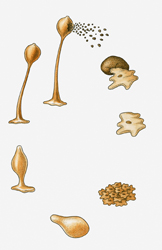Soil amoebae biodiversity
D are soil-inhabiting amoebae that build multi-cellular bodies. They have been studied for over 200 years, and include the widely used experimental biological model, Dictyostelium discoideum. Previous attempts to create molecular phylogeny of D revealed the deeply flawed traditional taxonomy of this group and the faulty evolutionary theories based upon it. The EU-financed ‘Evolution of form and function on a unique eukaryotic organism (Dictyostelia)’ ((DYCTITOL)) project aims to characterize D’s biodiversity and its molecular and morphological evolution. During the project, phylogeny for D was fully developed and expanded to include 50 new recent isolates from around the world. Researchers successfully contributed to the study of D diversity and taxonomy by creating new morphological patterns.Another main result from the project has been the development of molecular environmental sampling techniques for the study of D. Good specificity and sensitivity was achieved in sampling through application of polymerase chain reaction (PCR) – a modern molecular biology technique. The broad set of samples were tested and initial analyses showed new deep branches in all major divisions of D, with some samples representing new major divisions. This confirmed that a substantial proportion of D diversity remains to be discovered. The results also suggested that both water availability and the richness of plant species could facilitate D diversity indirectly, via their prey - bacteria. The PCR approach allowed examination of these questions on a broad scale for the first time.Altogether the project yielded ten publications and five presentations at the scientific meetings in five countries. The DYCTITOL program represents the first comprehensive study of eukaryotic amoebas. It successfully characterized the biodiversity, molecular and morphological evolution of D that will be critical for future studies on their role in ecology and soil in particular.







